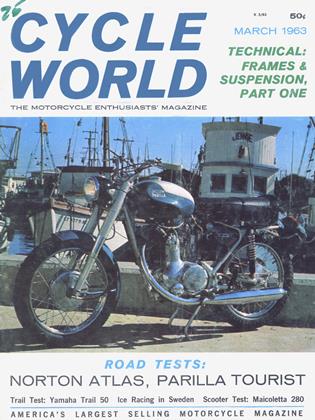MAICOLETTA
CW Scooter Test
GERMANY, long known for its products of excellent workmanship and engineering, produces some truly unique devices designed for the transporting of people. Most German-built machines, be they automobile, motorcycle or motor scooter, lean towards the rather large and heavy side of things with silence of operation and comfort foremost in consideration. We are at a loss to explain why, though we can be certain that the people of Germany could not possibly be more comfort - conscious than any of us.
The Maicoletta fills all of the precepts of a Teutonic machine; it is large, heavy, is delightfully comfortable and makes only the minimum of noises. But, quite unlike other machines of its gender, it performs in a most sporting manner. Top speed is stated to be 75 mph, and it gets there in very short order.
A quick review of the technical specifications tells the whole story: Engine, single cylinder, two-cycle, 280cc, 71mm bore, 70mm stroke, rated at 16.2 hp. The engine and four-speed transmission are in fact the same as used on the 250cc Maico motorcycle, with an enlarged bore to effect the larger displacement. Its low horsepower indicates that the port timing is of a considerably milder nature than its motorcycle predecessor. An interesting addition to the cycle engine use is the addition of a blower for cooling, as the engine is buried beneath the sheet metal body work and thus not exposed to an air stream.
Starting, in keeping with modern trends pioneered by the Japanese manufacturers, is by electricity. Depressing the starter button produces a rather strange sound that turns out to be eminating from the engine, which is not turning as one would expect, but rather is rocking back and forth. We were curious as to why this is done in this manner, rather than turning the engine in full revolutions. The only speculation we could arrive at was that possibly the voltage drain on the battery was less
than it would be in a conventional type of starter. We would like to have seen a kick starter as well; batteries have bad habits of running down.
German-built machines usually lean toward the luxurious side of things as well; witness the fine quality eight-day clock that is a standard element of the Maicoletta’s instrument panel in company with a speedometer. Though we are not equipped to test time pieces, it seemed to keep excellent time, if the Editor’s Timex is any judge.
Part of the massive appearance of the Maicoletta can be blamed upon the large disc-type metal wheels, and very large they are, a full 14" mounting 3:25/3:50-14 tires. We were very impressed with the front suspension which appears to be a shortened version of the telescopic forks on the Maico motorcycles. They are sufficiently soft, yet firm enough for the job, and contribute extensively to an excellent handling machine.
Suspension in the rear is by parallel swinging arms with twin shock absorbers. All of this sounds like the description of a road going motorcycle, which for a fact the Maicoletta virtually is, with 14" wheels of course. Repairmen will like this scooter as well; the entire rear body shell is easily removable for full and easy access to the vital components. One last detail we were amused by was a little window on the instrument panel with a number registering in it, telling the rider which gear the machine is in at time. We found it useful occasionally. Gear changing is performed with a pair of pedals acting similarly to the change lever on a cycle (i.e.; down on the forward pedal for first, down on the rear pedal for the other three gears.) Six attractive color combinations are available, and the last item, the price, $645.00, is what the luxury loving scooter rider will have to pay White Mtrs., in Costa Mesa, Calif., distributors in the West. Maico Mtr. Co. in Detroit distributes the line in the East. •
 View Full Issue
View Full Issue
More From This Issue
-

Cycle Round Up
March 1963 By Joseph C. Parkhurst -

The Service Department
March 1963 By Gordon H. Jennings -

German Two-Wheel Museum
March 1963 By Sloniger -

Ice Racing In Sweden
March 1963 By Bengt Bjorklund -
 Trail Test
Trail TestYamaha Omaha Trail
March 1963 -
 Technical
TechnicalFrames & Suspension
March 1963 By Gordon H. Jennings


